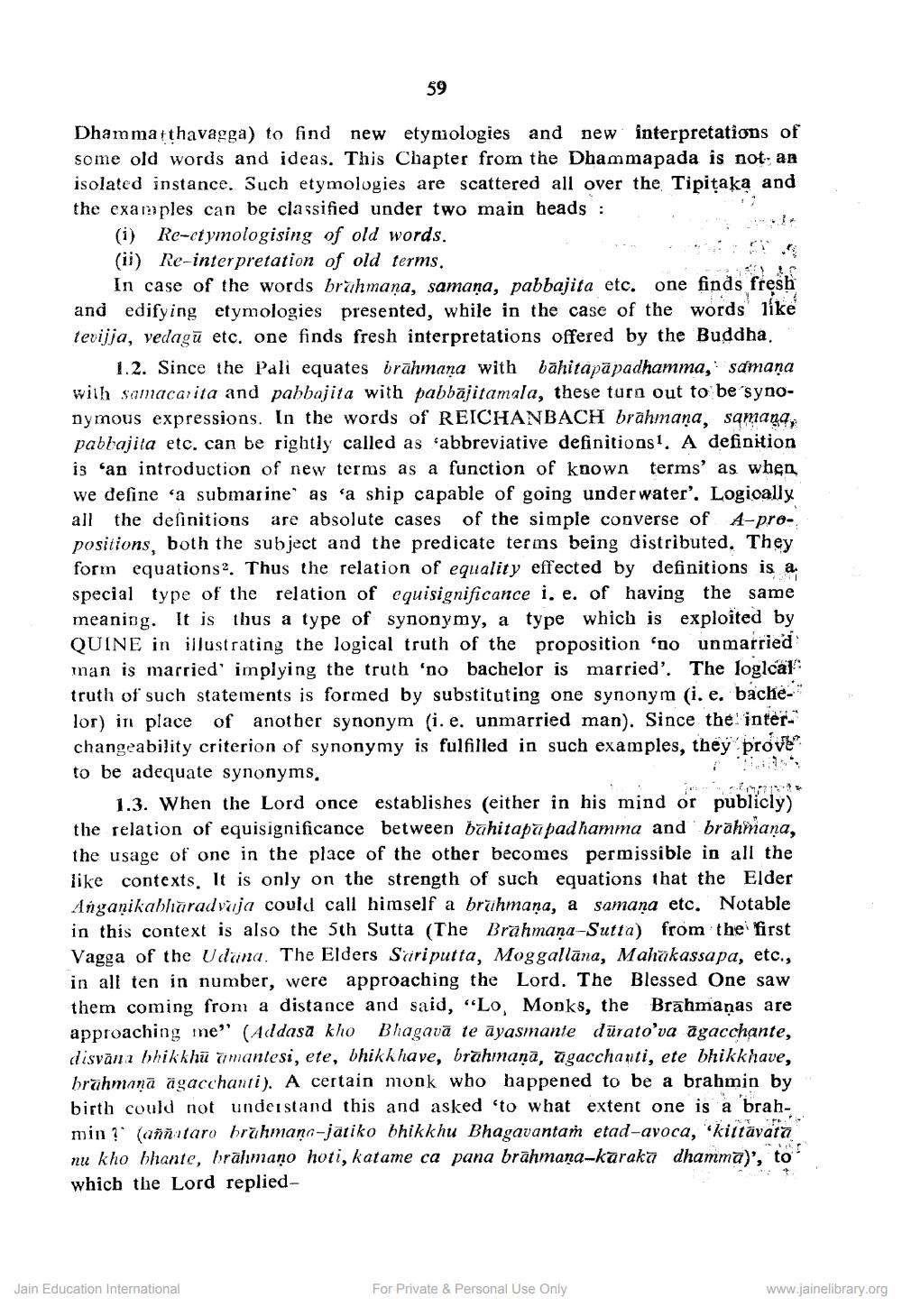________________
59
Dhamma thavagga) to find new etymologies and new interpretations of some old words and ideas. This Chapter from the Dhammapada is not an isolated instance. Such etymologies are scattered all over the Tipitaka and the examples can be classified under two main heads :
(i) Re-etymologising of old words.
(ii) Re-interpretation of old terms.
In case of the words brahmana, samaṇa, pabbajita etc. one finds fresh and edifying etymologies presented, while in the case of the words like tevijja, vedagu etc. one finds fresh interpretations offered by the Buddha.
1.2. Since the Pali equates brāhmaṇa with bahitapāpadhamma, samaṇa with samacarita and pabbajita with pabbajitamala, these turn out to be synonymous expressions. In the words of REICHANBACH brahmana, samana, pabbajita etc. can be rightly called as abbreviative definitions1. A definition is an introduction of new terms as a function of known terms' as when we define a submarine' as 'a ship capable of going under water'. Logically all the definitions are absolute cases of the simple converse of A-propositions, both the subject and the predicate terms being distributed. They form equations. Thus the relation of equality effected by definitions is a special type of the relation of equisignificance i. e. of having the same meaning. It is thus a type of synonymy, a type which is exploited by QUINE in illustrating the logical truth of the proposition 'no unmarried man is married' implying the truth 'no bachelor is married'. The logical truth of such statements is formed by substituting one synonym (i. e. bachelor) in place of another synonym (i. e. unmarried man). Since the interchangeability criterion of synonymy is fulfilled in such examples, they prove to be adequate synonyms.
0771
1.3. When the Lord once establishes (either in his mind or publicly) the relation of equisignificance between bahitapupadhamma and brāhmaṇa, the usage of one in the place of the other becomes permissible in all the like contexts. It is only on the strength of such equations that the Elder Anganikabharadvaja could call himself a brahmana, a samana etc. Notable in this context is also the 5th Sutta (The Brahmana-Sutta) from the first Vagga of the Udana. The Elders Sariputta, Moggallana, Mahakassapa, etc., in all ten in number, were approaching the Lord. The Blessed One saw them coming from a distance and said, "Lo, Monks, the Brahmanas are approaching me" (Addasa kho Bhagava te ayasmante dürato'va agacchante, disvāna bhikkhu amantesi, ete, bhikkhave, brāhmaṇa, agacchanti, ete bhikkhave, brahmana agacchanti). A certain monk who happened to be a brahmin by birth could not understand this and asked to what extent one is a brahmin? (aññataro brāhmaṇa-jatiko bhikkhu Bhagavantaṁ etad-avoca, 'kittävatā nu kho bhante, brahmano hoti, katame ca pana brāhmaṇa-kāraka dhamma)', to which the Lord replied
•T..!
Jain Education International
For Private & Personal Use Only
www.jainelibrary.org




